Style Sheet
Prior to submitting, please revise your contribution according to the following guidelines. Confirming that your submission follows these guidelines will significantly expedite publication. Use this style sheet/guide for all text-based material: articles, notes, and metacommentary on multimedia. Once your contribution is officially accepted, you will have the opportunity to review your contribution once more to ensure alignment with the style guide. All contributions will be edited and proofread prior to publication to ensure they meet the journal’s standards for language and style.
Formatting
Proofs. Authors are consulted throughout the copy-editing process. Prior to the publication of a contribution, contributors will have the opportunity to see a proof of their piece on the journal website. Other revisions to images and their placement can be made at that stage.
File Types. Submissions should be saved as editable DOC or DOCX files. (See “Instructions for Contributors.”) All images should be sent as separate JPG or PNG files. (See “Captions” below.)
Cover Page. Every manuscript should include the full name of each contributor on a cover page separate from the manuscript. For papers that will be double-blind peer reviewed, the body of the manuscript should include no identification of any contributor.
Title and Top of the Page. At the top of your contribution, type your title in Title Case (MLA style). Below that, affix your fifty-word abstract, after or under the word “Abstract.” There should be no references/citations in the title. (Our website platform doesn’t permit note function in the title or abstract; however, we are switching to in-text parenthetical citations, which would be fine in the abstract.)
Epigraphs. If you intend to use an epigraph, please use Roman font (rather than italics), justify it right, and after a long (em) dash, type the originator’s first and last name, a comma, and the title of the work from which the quotation was excerpted. Ensure that work appears in your works cited list.
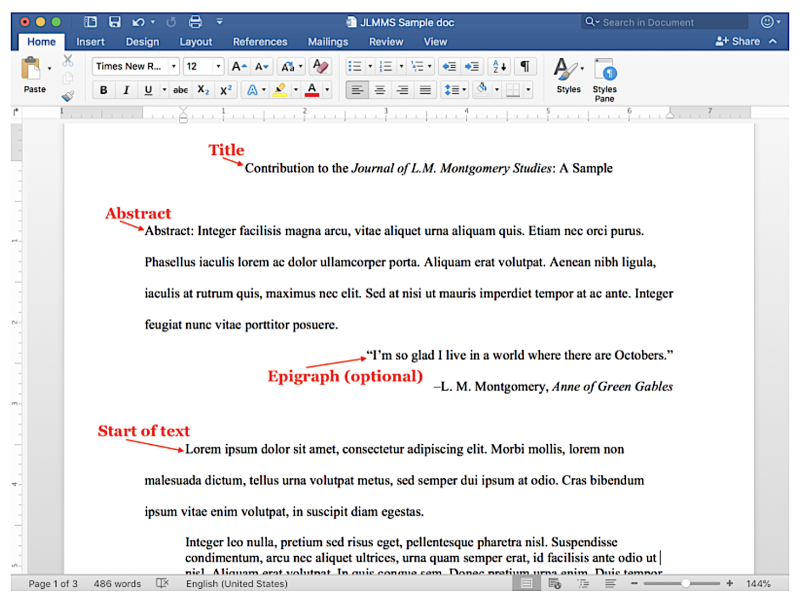
Subheadings. The use of subheadings in text-heavy contributions is encouraged. These headings will float along the page to help readers navigate the sections of text. If your contribution uses subheadings, the first set of these (A-heads) should be left justified and bolded. Please keep subheadings succinct. Mark the second level of subheading (B-level) by tabbing the left margin in once and bolding the heading. Again, make the subheading succinct. C-levels are tabbed in twice and italicized. For example:
Subheading A
Subheading B
Subheading C
The final, published appearance of these subheadings may vary given the formatting of the contribution on the website itself, but contributors will have the opportunity to see them in the proof stage.
Captions. As described in the “Instructions for Contributors,” images must be submitted separately from text files (for ease of uploading into the website). On a separate page, please list all captions and save images with corresponding file names. Indicate with square brackets where you would like your image to appear in the article—for example, [Image 1 here]. While due to the web environment, we can’t guarantee that placement, the editors will work with the contributor during the proof stage to best display the publication. Model image captions are available here.
Alternative (Alt) Text. Alt text will be required of all images embedded in a publication. The author should include alt text in the caption text file they submit with their final manuscript. Alt text is required for all images in addition to captions, because, unlike captions, which contain publication information (for example, illustrator or place and date of publication), alt text focuses on the visual components of an image.
Alt text is classified as any description that is less than 125 characters and describes the basic details of an image. To make the descriptions compatible with popular screen readers, please use less than 125 characters whenever possible.
Alt text could include details about colour, placement, image style, names, emotions, and settings where relevant. Alt text enhances accessibility, allowing users of screen readers to engage with image content; these descriptions will be displayed in place of an image if it fails to load. Further information, including model alt text is available here.
Affiliation. Affiliations are not required. If you would like to include an institutional or other affiliation(s), please list them exactly as you would like them to appear in the journal. Affiliations are included before the Notes and Works Cited (for example, University of Ontario, Independent Scholar, or the Centre for Research in Young People’s Texts and Cultures, University of Winnipeg).
Acknowledgements. Should you need or wish to include an Acknowledgements section, place it between your Affiliation and your Notes, both of which precede your Works Cited page.
Permissions. Should you need to include a Permissions section, place it between your Affiliation (or Acknowledgements) and your Notes, both of which precede your Works Cited page. Any substantial material not created by the contributing author(s) should be used only 1) if it is no longer protected by copyright OR 2) with permission of the copyright holders. Contributors may submit pieces before securing these permissions, but permissions must be secured before the piece can be published. More information about Montgomery material protected by copyright and about seeking permissions can be found in our Open Access and Copyright statements. The journal’s editors are happy to provide guidance to contributors on securing permissions, but ultimately it is the responsibility of the author(s) to secure permissions.
Funding Details. Please supply all details required by your funding and grant-awarding bodies as follows:
- For single-agency grants:
- This work was supported by the [Funding Agency] under Grant [number xxxx].
- For multiple-agency grants:
- This work was supported by the [Funding Agency #1] under Grant [number xxxx]; [Funding Agency #2] under Grant [number xxxx]; and [Funding Agency #3] under Grant [number xxxx].
Works Cited. Note that we use a list of works cited, not a bibliography. Before finally submitting your accepted contribution, double-check that all entries on your works cited list are cited in this version of your contribution.
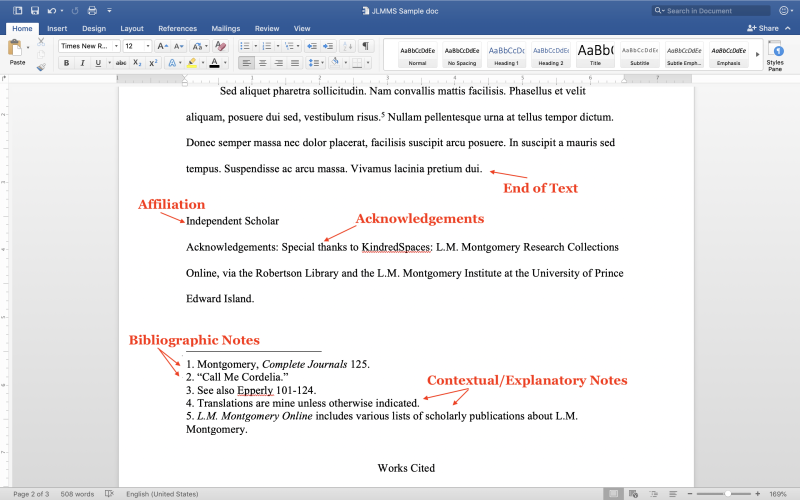
Style and Formatting
Style. The Journal of L.M. Montgomery Studies follows the formatting and citation guidelines laid out in the eighth edition of the MLA Handbook (2016). In addition to samples provided below, the MLA Style Center includes examples, templates, and guides that may be useful to you as a contributor.
The journal is transitioning from endnotes to in-text parenthetical citations. Check with your collection co-editor(s) if you’re unsure what format you should be using. Original style sheet instructions: Contributors should present citations in the format used for MLA-style parenthetical citations; however, rather than enclosing them in parentheses, contributors should present them as endnotes. Updated style sheet: Contributors should now include MLA-style parenthetical citations. You may, however, want to include brief content or explanatory notes for digressionary or additional material. Please use MS Word’s endnote function for this purpose. Contributors should include a works cited list at the end of the text. (See samples below.) The MLA Style Center provides more information about and samples of these notes. All contributions must follow MLA style.
Endnotes/Parenthetical Citations. For its initial collections (Reading, Vision, Mental Health, International Notes, and Re-vision), the journal only used endnotes. Original style sheet: All accepted contributions must use endnotes rather than footnotes. These notes should be used to cite sources, clarify terms, contextualize ideas, or refer to further reading. For consistency, the content and format of bibliographic endnotes should follow MLA style for parenthetical citations, without the parentheses and with a period for end punctuation. See samples below. In the submission, the notes list appears before the works cited list.
Updated style sheet: Later submissions (starting with L.M. Montgomery and the Politics of Home) will use parenthetical citations. The citation style will be the same, but authors must include citations as parenthetical citations, rather than footnotes.
Further information and sample in-text parenthetical citations can be found at the Purdue OWL OR on EasyBib.
Abbreviations. For ease of referencing and reading, the journal uses abbreviations for Montgomery’s texts. (See a complete list below.)
Editions. Where possible, we encourage authors to quote from Montgomery’s Complete Journals, rather than the Selected Journals. (Questions or concerns should be directed to the collection co-editor[s].)
Bibliography Software. Contributors who use bibliography management software (for example, Endnote, Zotero, etc.) may submit BibTeX or RIS files.
Dictionary. The journal follows the Canadian Oxford Dictionary.
Format for Dates. Use day, month, year format. For example, write 10 June 2020 rather than June 10, 2020.
Font. The entire submission (contribution, quotations, works cited page, notes, etc.) must be in 12-point, Times New Roman font.
Italics/Underlining. The journal uses italics rather than underlining (when required, for example, in titles of long-form works like novels).
Spacing. Double space your entire document (title, epigraphs, contribution, quotations, notes, works cited page, etc.). Remove all double spaces after periods. (To make this removal, using a “find and replace” function is easiest.)
Headers and Footers. Remove all headers and footers, except page numbers.
Hyperlinks. Please provide hyperlinks in comment boxes to indicate words/phrases that you would like to see hyperlinked in your online text. This provides an opportunity to link to important sites and extend the conversation, but use hyperlinks judiciously. In your initial submission, this will look like the following:
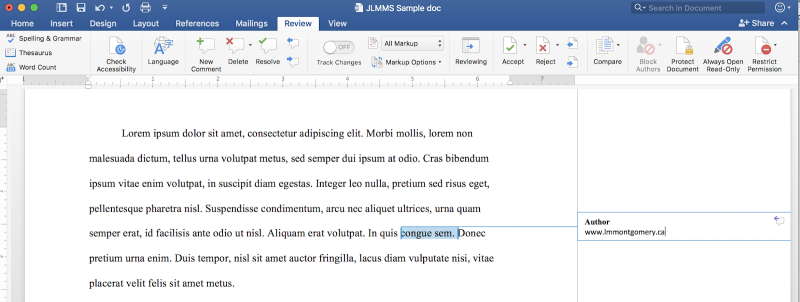
In the published version of the text, the hyperlinks will be embedded as below (sample from the Journal of L.M. Montgomery Studies):
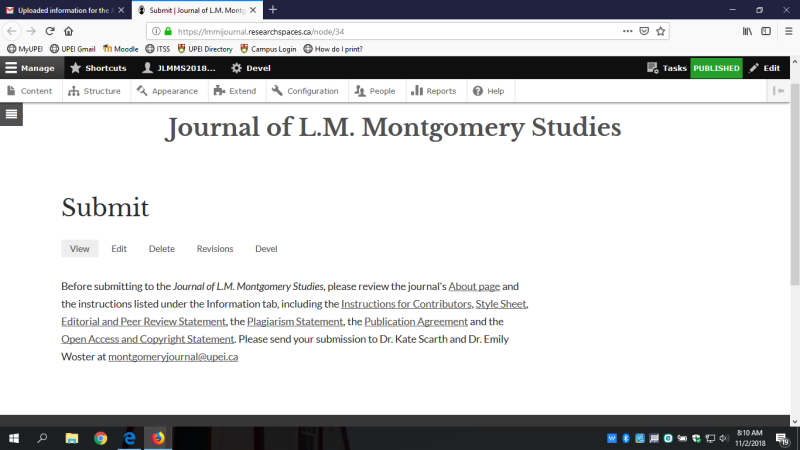
Punctuation.
-
Oxford comma: We retain the Oxford comma.
-
Ellipses: Use smart-ellipses (...), rather than three spaced dots ( . . . ). Also, do not use brackets () or [ ] around ellipses in quotations unless they are represented that way in the original quotation.
-
Emphasis: Do not use quotation marks and italics solely for emphasis, except where they are part of a quotation. You may indicate “emphasis in the original” or “my emphasis,” in consultation with the journal copy editor(s).
Quotations.
-
Accuracy: Check quotations used in your contribution against the original to make sure you have the correct wording. Upper and lower case should be as in the original; use square brackets if you make changes. Also, make sure every quotation has a citation and that all entries in the works cited list are actually cited in this version of the contribution.
-
Quotation Marks: Quotations are set to American style rather than British. In other words, do not use single-quotation marks (‘), except for a quotation within another quotation. Also, confirm that your contribution has quotation marks (“) to open and close all quotations. Ensure that your quotation marks and apostrophes are curly (smart), not straight.
-
Block Quotes: Contributors should use block-quote formatting for quotations longer than four lines. See the example below:
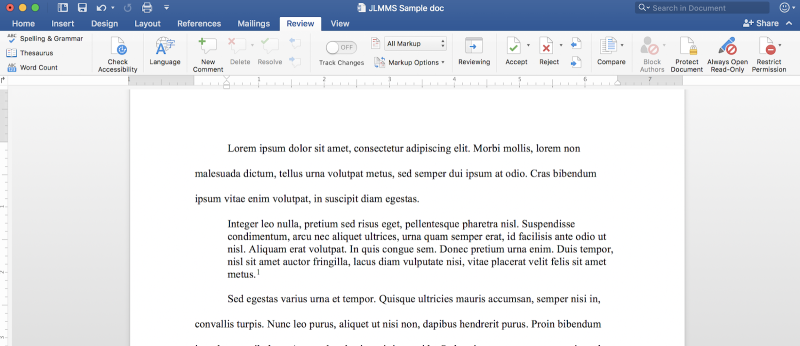
Dates of Publication. Remove all parenthetical dates of publication in your text (not your works cited list), unless the dates are relevant to your argument.
Lists. When using a list in your contribution, format numbers with Arabic numerals followed by a single close parenthesis: 1), 2), etc.
Field Codes and Linked Bibliographies. Remove all field-code created information in your text, cutting and pasting entries if need be to unlink them.
Translations and Translators.
Translation of Quotations: Either integrate short passages in the original language followed by translations and references in parentheses, or short translations followed by the original passage and reference in parentheses. Be consistent in whether you include the original or the translation first. If you are the translator, put “my trans.” in the parenthetical reference. Here are some examples:
At the opening of Dante’s Inferno, the poet finds himself in “una selva oscura” (“a secret wood”; 1.2; Ciardi 28).
Sévigné responds to praise of her much admired letters by acknowledging that “there is nothing stiff about them” (“pour figées, elles ne le sont pas”; my trans.; 489).
For quoted passages that run longer than four lines, follow the reference guidelines for shorter passages as outlined above, and format in accordance with guidelines for block quotations.
If many of the translations are your own, instead of “my trans.” you can insert an endnote after your first translation indicating which translations are your own. In this case, don’t include “my trans.” in the parenthetical references covered in this endnote.
Translation of title in the text and in the works cited: If your readers are unlikely to understand the title of the original work, put the translation in round brackets in the text but square brackets in the works cited. Here are some examples:
Isabel Allende based her novel La casa de los espiritus (The House of the Spirits) on a letter she had written to her dying grandfather.
Allende, Isabel. La casa de los espiritus [The House of the Spirits]. Plaza & Janés, S.A., 1982.
Translated works in the works cited: When the focus of your paper is on the translation, treat the translator as the author. Example:
Pevear, Richard, and Larissa Volokhonsky, translators. Crime and Punishment. By Fyodor Dostoevsky, Vintage ebooks, 1993.
If the translation itself is not your focus, then include the translator after the title. Example:
Chartier, Roger. The Order of Books: Readers, Authors, and Libraries in Europe between the Fourteenth and Eighteenth Centuries. Translated by Lydia G. Cochrane, Stanford UP, 1994.
Abbreviations.
Fiction
AA = Anne of Avonlea
AGG = Anne of Green Gables
AIs = Anne of the Island
AHD = Anne's House of Dreams
AIn = Anne of Ingleside
AWP = Anne of Windy Poplars
BAQ = The Blythes Are Quoted
BC = The Blue Castle
CA = Chronicles of Avonlea
EC = Emily Climbs
ENM = Emily of New Moon
EQ = Emily's Quest
FCA = Further Chronicles of Avonlea
GR = The Golden Road
JLH = Jane of Lantern Hill
KO = Kilmeny of the Orchard
MM = Magic for Marigold
MP = Mistress Pat
PSB = Pat of Silver Bush
RI = Rilla of Ingleside
RV = Rainbow Valley
RY = The Road to Yesterday
SG = The Story Girl
TW = A Tangled Web
Life-Writing
AP = The Alpine Path
CJ 1 = The Complete Journals of L.M. Montgomery: The PEI Years, 1889–1900
CJ 2 = The Complete Journals of L.M. Montgomery: The PEI Years, 1901–1911
CJ 3 = L.M. Montgomery’s Complete Journals: The Ontario Years, 1911–1917
CJ 4 = L.M. Montgomery’s Complete Journals: The Ontario Years, 1918–1921
CJ 5 = L.M. Montgomery’s Complete Journals: The Ontario Years, 1922–1925
CJ 6 = L.M. Montgomery’s Complete Journals: The Ontario Years, 1926–1929
CJ 7 = L.M. Montgomery’s Complete Journals: The Ontario Years, 1930–1933
SJ 1 = The Selected Journals of L.M. Montgomery: Volume 1, 1889–1910
SJ 2 = The Selected Journals of L.M. Montgomery: Volume 2. 1910–1921
SJ 3 = The Selected Journals of L.M. Montgomery: Volume 3. 1921–1929
SJ 4 = The Selected Journals of L.M. Montgomery: Volume 4. 1929–1935
SJ 5 = The Selected Journals of L.M. Montgomery: Volume 5. 1935–1942
Note: For ease of movement between the selected and complete journals, in all endnotes, please include the date in your text or in parentheses. For example, a reference from page 32 of CJ 5 would be referenced as Montgomery, CJ 5 (10 May 1922): 32.
Reminder: Unless discussing The Selected Journals, for journal entries up to 1933, whenever possible, please refer to The Complete Journals rather than The Selected Journals.
Standard Works Cited Entries for LMM Journals
Updated 6 June 2023
Selected Journals (please use the following one standard works cited entry for any reference to any one or more of The Selected Journals):
Montgomery, L.M. The Selected Journals of L.M. Montgomery. Edited by Mary Rubio and Elizabeth Waterston, Oxford UP, 1985–2004. 5 vols.
Reminder: Unless discussing The Selected Journals, for journal entries up to 1933, whenever possible, please refer to The Complete Journals rather than The Selected Journals.
Complete Journals (please use the following standard works cited entries for any specific volumes of The Complete Journals you refer to):
Montgomery, L.M. The Complete Journals of L.M. Montgomery: The PEI Years, 1889–1900. [CJ 1]. Edited by Mary Henley Rubio and Elizabeth Hillman Waterston, Oxford UP, 2012.
---. The Complete Journals of L.M. Montgomery: The PEI Years, 1901–1911. [CJ 2]. Edited by Mary Henley Rubio and Elizabeth Hillman Waterston, Oxford UP, 2017.
---. L.M. Montgomery’s Complete Journals: The Ontario Years, 1911–1917. [CJ 3]. Edited by Jen Rubio, Rock’s Mills Press, 2016.
---. L.M. Montgomery’s Complete Journals: The Ontario Years, 1918–1921. [CJ 4]. Edited by Jen Rubio, Rock’s Mills Press, 2017.
---. L.M. Montgomery’s Complete Journals: The Ontario Years, 1922–1925. [CJ 5]. Edited by Jen Rubio, Rock’s Mills Press, 2018.
---. L.M. Montgomery’s Complete Journals: The Ontario Years, 1926–1929. [CJ 6]. Edited by Jen Rubio, Rock’s Mills Press, 2017.
---. L.M. Montgomery’s Complete Journals: The Ontario Years, 1930–1933. [CJ 7]. Edited by Jen Rubio, Rock’s Mills Press, 2019.